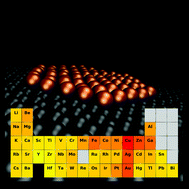Stability limits of elemental 2D metals in graphene pores†
Abstract
Two-dimensional (2D) materials can be used as stabilizing templates for exotic nanostructures, including pore-stabilized, free-standing patches of elemental metal monolayers. Although these patches represent metal clusters under extreme conditions and are thus bound for investigations, they are poorly understood as their energetic stability trends and the most promising elements remain unknown. Here, using density-functional theory simulations and the liquid drop model to explore the properties of 45 elemental metal candidates, we identify metals that enable the largest and most stable patches. Simulations show that pores can stabilize patches up to ∼8 nm2 areas and that the most prominent candidate in a graphene template is Cu. The results, which are generalizable to templates also beyond graphene, provide encouragement for further, even more resolute experimental pursuit of 2D metals.



 Please wait while we load your content...
Please wait while we load your content...